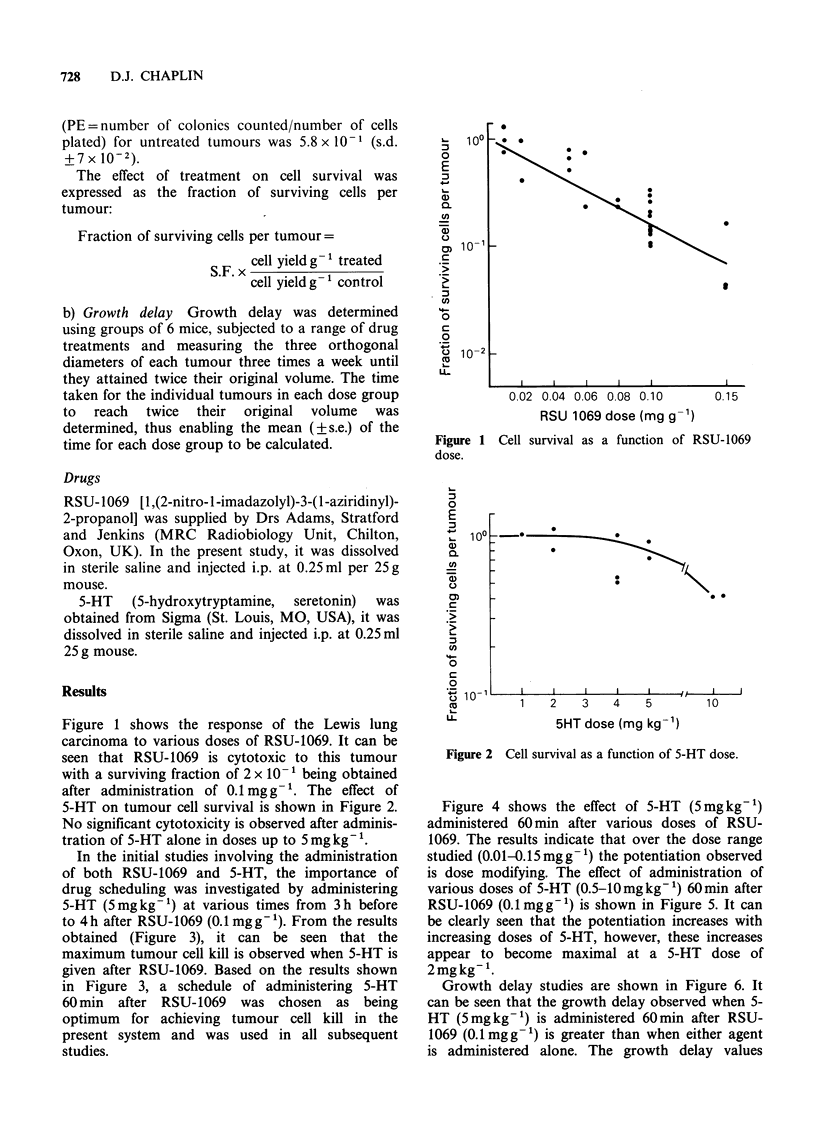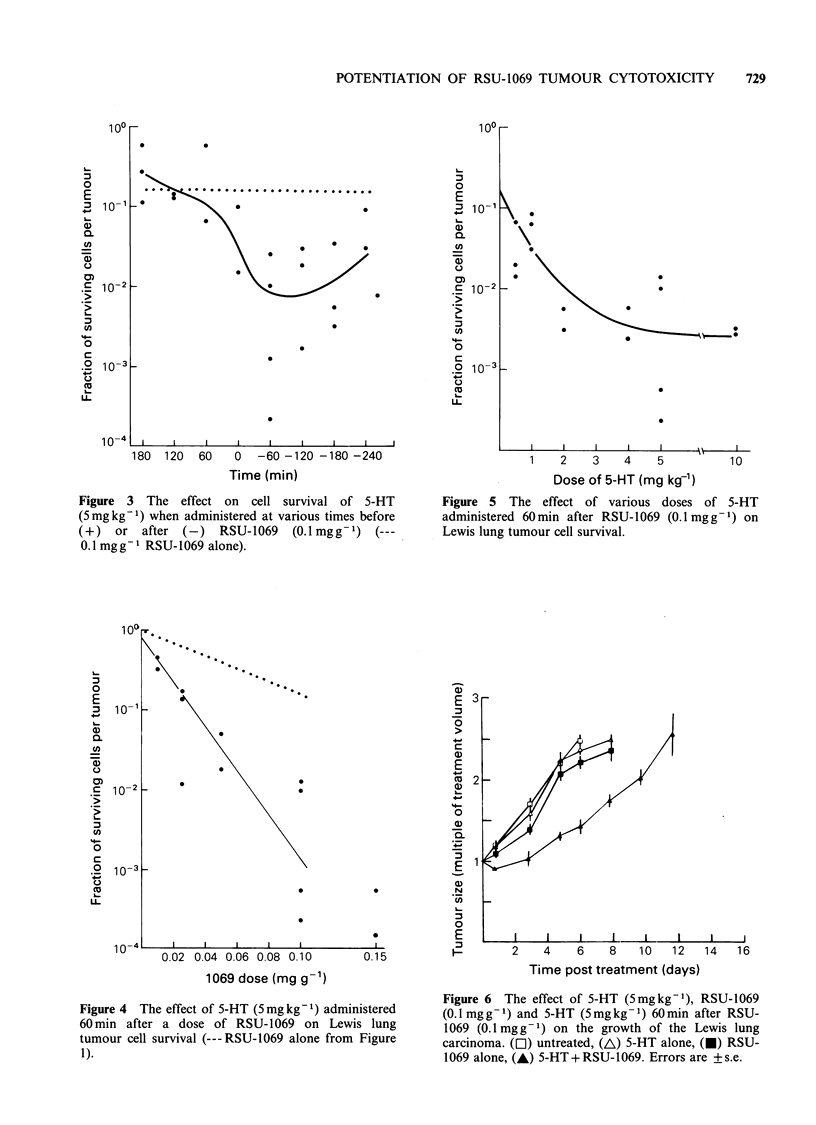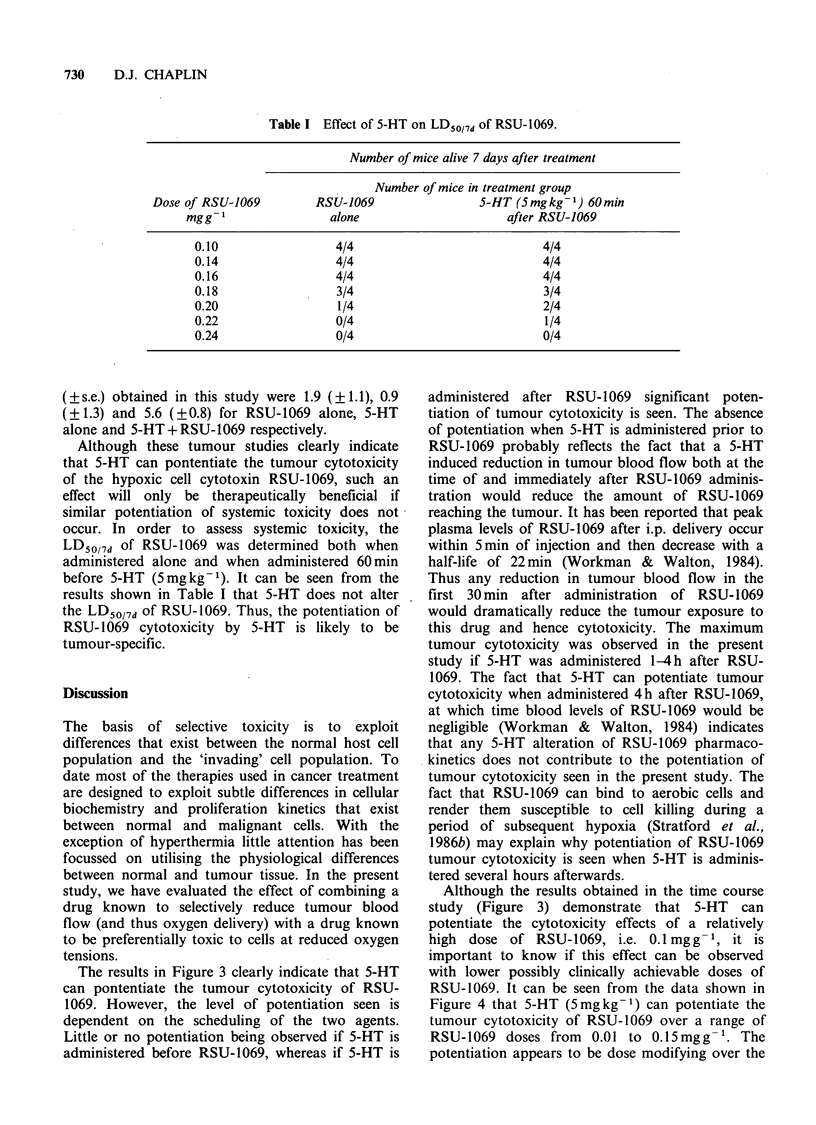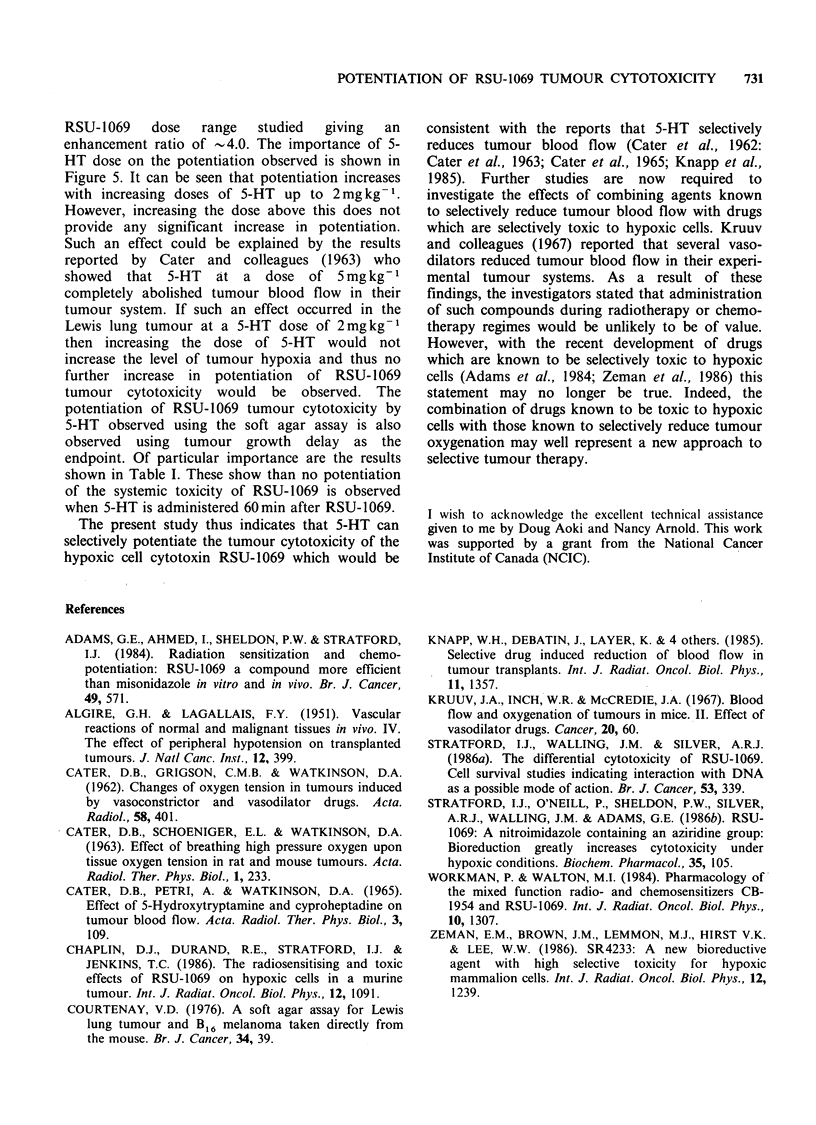Abstract
It is known that many solid animal tumours have a lower oxygenation level than most normal tissues and, in addition, that this level of oxygenation can be further decreased by systemic administration of 5-hydroxytryptamine (5-HT). The present study has investigated if such selective decrease in tumour oxygenation can be exploited by using the hypoxic cell cytotoxin, RSU-1069. The results obtained show that 5-HT at a dose of 5 mg kg-1, although not cytotoxic alone, can potentiate the cytotoxic effects of RSU-1069 in the Lewis lung carcinoma over the dose range 0.01-0.15 mg g-1. Maximum potentiation occurs when 5-HT is administered after RSU-1069. Potentiation of RSU-1069 cytotoxicity was observed using both the soft agar excision assay as an endpoint as well as in situ growth delay. In addition, the study shows that potentiation of RSU-1069 (0.1 mg g-1) cytotoxicity can be seen with 5-HT doses as low as 0.5 mg kg-1. In contrast to the tumour cytotoxicity results, 5-HT at a dose of 5 mg kg-1 i.p. did not affect the systemic toxicity, as measured by LD50/7d of RSU-1069. Thus, these results indicate that 5-HT can increase the therapeutic efficiency of RSU-1069. Such a finding is consistent with the rationale that selective reduction in tumour blood flow and oxygenation induced by 5-HT can be exploited using the hypoxic cell cytotoxin RSU-1069.
Full text
PDF




Selected References
These references are in PubMed. This may not be the complete list of references from this article.
- AATER D. B., PETRIE C., WATKINSON D. A. EFFECT OF 5-HYDROXYTRYPTAMINE AND CYPROHEPTADINE ON TUMOUR BLOOD FLOW; ESTIMATION BY RATE OF COOLING AFTER MICROWAVE DIATHERMY. Acta Radiol Ther Phys Biol. 1965 Apr;3:109–128. doi: 10.3109/02841866509133085. [DOI] [PubMed] [Google Scholar]
- ALGIRE G. H., LEGALLAIS F. Y. Vascular reactions of normal and malignant tissues in vivo. IV. The effect of peripheral hypotension on transplanted tumors. J Natl Cancer Inst. 1951 Oct;12(2):399–421. [PubMed] [Google Scholar]
- Adams G. E., Ahmed I., Sheldon P. W., Stratford I. J. Radiation sensitization and chemopotentiation: RSU 1069, a compound more efficient than misonidazole in vitro and in vivo. Br J Cancer. 1984 May;49(5):571–577. doi: 10.1038/bjc.1984.91. [DOI] [PMC free article] [PubMed] [Google Scholar]
- CATER D. B., GRIGSON C. M., WATKINSON D. A. Changes of oxygen tension in tumours induced by vasoconstrictor and vasodilator drugs. Acta radiol. 1962 Dec;58:401–434. doi: 10.3109/00016926209169582. [DOI] [PubMed] [Google Scholar]
- CATER D. B., SCHOENIGER E. L., WATKINSON D. A. EFFECT OF BREATHING HIGH PRESSURE OXYGEN UPON TISSUE OXYGEN TENSION IN RAT AND MOUSE TUMOURS. Acta Radiol Ther Phys Biol. 1963 Aug;1:233–252. doi: 10.3109/02841866309135083. [DOI] [PubMed] [Google Scholar]
- Chaplin D. J., Durand R. E., Stratford I. J., Jenkins T. C. The radiosensitizing and toxic effects of RSU-1069 on hypoxic cells in a murine tumor. Int J Radiat Oncol Biol Phys. 1986 Jul;12(7):1091–1095. doi: 10.1016/0360-3016(86)90233-6. [DOI] [PubMed] [Google Scholar]
- Courtenay V. D. A soft agar colony assay for Lewis lung tumour and B16 melanoma taken directly from the mouse. Br J Cancer. 1976 Jul;34(1):39–45. doi: 10.1038/bjc.1976.119. [DOI] [PMC free article] [PubMed] [Google Scholar]
- Knapp W. H., Debatin J., Layer K., Helus F., Altmann A., Sinn H. J., Ostertag H. Selective drug-induced reduction of blood flow in tumor transplants. Int J Radiat Oncol Biol Phys. 1985 Jul;11(7):1357–1366. doi: 10.1016/0360-3016(85)90252-4. [DOI] [PubMed] [Google Scholar]
- Kruuv J. A., Inch W. R., McCredie J. A. Blood flow and oxygenation of tumors in mice. II. Effects of vasodilator drugs. Cancer. 1967 Jan;20(1):60–65. doi: 10.1002/1097-0142(1967)20:1<60::aid-cncr2820200109>3.0.co;2-c. [DOI] [PubMed] [Google Scholar]
- Stratford I. J., O'Neill P., Sheldon P. W., Silver A. R., Walling J. M., Adams G. E. RSU 1069, a nitroimidazole containing an aziridine group. Bioreduction greatly increases cytotoxicity under hypoxic conditions. Biochem Pharmacol. 1986 Jan 1;35(1):105–109. doi: 10.1016/0006-2952(86)90566-6. [DOI] [PubMed] [Google Scholar]
- Stratford I. J., Walling J. M., Silver A. R. The differential cytotoxicity of RSU 1069: cell survival studies indicating interaction with DNA as a possible mode of action. Br J Cancer. 1986 Mar;53(3):339–344. doi: 10.1038/bjc.1986.57. [DOI] [PMC free article] [PubMed] [Google Scholar]
- Workman P., Walton M. I. Pharmacology of the mixed-function radio- and chemosensitizers CB 1954 and RSU 1069. Int J Radiat Oncol Biol Phys. 1984 Aug;10(8):1307–1310. doi: 10.1016/0360-3016(84)90337-7. [DOI] [PubMed] [Google Scholar]
- Zeman E. M., Brown J. M., Lemmon M. J., Hirst V. K., Lee W. W. SR-4233: a new bioreductive agent with high selective toxicity for hypoxic mammalian cells. Int J Radiat Oncol Biol Phys. 1986 Jul;12(7):1239–1242. doi: 10.1016/0360-3016(86)90267-1. [DOI] [PubMed] [Google Scholar]


